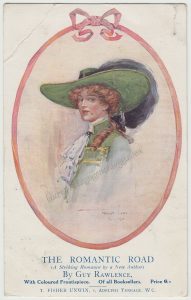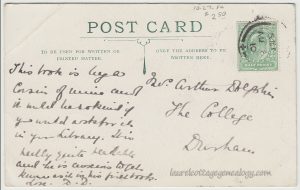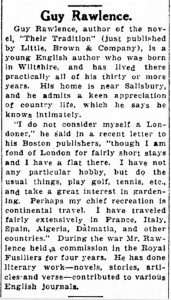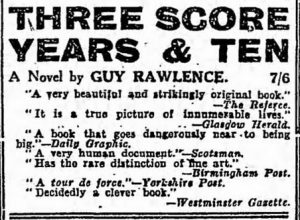

Divided back, artist-signed postcard. Postmarked August 8, 1910, England. Artist: Wilmot Lunt. City of postmark unknown.
Price: $30.00
The postcard artist
The beautiful artwork for this postcard is that of the frontispiece (the page adjacent to the title page of a book) and is signed Wilmot Lunt. He was Samuel Wilmot Lunt (1856 – 1939) painter and cartoonist, and was also the illustrator for R. D. Blackmore’s Lorna Doone. For more on Lunt see James Malone Farrell’s article, “Keeping the Home Folks Laughing” published in Cartoons Magazine, July 1918.
The reverse of the card shows:
“This book is by a cousin of mine and it would be so kind if you would ask for it in your Library. It is really quite readable and he is anxious[?] to [?] know[?] as it is his first book. Love, D. D.”
Addressed to: “Rvd. Arthur Dolphin. The College, Durham”
A great find
This postcard turns out to have been a pretty neat find: It’s not in the best of shape but is seemingly rare, the only one found so far, plus the note to the addressee contains a little insight regarding the author’s feelings, according to his cousin, about the release of his first book. Some of the sender’s handwriting is difficult to read, but I think the word there is “anxious” rather than “curious” and who would not be anxious regarding the reception of their first major work?
Armchair research
It’s a little surprising (same for the postcard artist) that there is no Wikipedia or similar type entry yet on the author; we found mention of over twenty titles to his credit. Our web post here will not be in-depth, as that would require much more research, so we’ll just offer instead bits and pieces gleaned from the usual sources, including an article we found in which the author is quoted. But it’s fascinating how a little fact-finding can get the imagination going….while pulling up bits of information one pictures pieces of a puzzle starting to take shape. For instance, for me, I’m surmising Guy Lawrence liked dogs (therefor I like him) as he did at least four books about dogs, Doings In Dogland (1905), Biffin & Buffin (1934), Tob and His Dog (1938) and Bob et Bobby (1963) the latter being in french, and written with Julianna Ewing. But then after coming across an ad for sheepdog-training that stressed the necessity of correct instruction (the working dog would be vital to the livestock holder) next to a mention of James Rawlence, Esq., Guy’s grandfather, agriculturist and livestock breeder, it hit me that Guy probably grew up around dogs. Not that this is any great revelation, or not that one wouldn’t have assumed this anyway, but at this point this “dog” puzzle piece became something specific to the whole picture; it shimmered into view, and that seemed charming. But, I guess the bottom line is that our imagination about someone else’s life tells us, for sure, something about ourselves, and possibly, if we’ve intuited correctly, something about the person in question.
Guy Rawlence (1888 – 1971)
Edward Guy Rawlence was born March 10, 1888, baptized May 10, 1888 in Wilton, Wiltshire County, England, son of James Edward Rawlence, whose occupation at the time was given as auctioneer, and Constance (maiden name Vivian) Rawlence. That’s livestock auctioneer for J. E. Rawlence, as J. E.’s father (Guy’s grandfather) was James Rawlence, a very prominent land agent, agriculturist and livestock breeder in the area. Judging from a number of newspaper articles, Guy Rawlence’s stories received mostly positive reviews. The Romantic Road, published in 1910, was found mentioned in the following “snippet” view in the publication, Wiltshire Archaeological and Natural History Magazine, Vol. 34, and informs us that this book about a “girl highwayman” was well-reviewed and the story setting was largely in the author’s backyard. Rawlence would have been about twenty-two when it was published.

Prior to 1910, we found mention of a short story, The White Cavalier, circa 1905, and as previously stated, the children’s book Doings in Dogland (1905). The Highwayman, published in 1911, may have been, judging by the date, Rawlence’s second novel. Click the link to see the eBook.
Below, we were happy to come across this article, in which the author is quoted, from The Decatur Daily Review (Decatur, IL) July 1, 1927.

Gushing reviews for Three Score & Ten, appeared in London’s The Observer, October 16, 1924.

Another book we’d like to read, in addition to the above, per the review that appeared in The Observer, November 17, 1935.

Update – from Lynne B. (a relative of Guy) who very kindly gives us the following:
“Guy Rawlence was my late husband’s great uncle but unfortunately I do not know much about him personally or as an author except that, as well as a number of novels Guy also wrote one-act plays, and short stories which were published in newspapers and journals.
This postcard was written by Dorothy Dolphin to her husband’s nephew, Reverend Arthur Rollinson Dolphin, who was a Clerk in Holy Orders (Church of England), Minor Canon and Schoolmaster at the Diocesan Mission House in Durham. I think the first word on the address is possibly Revd (the standard abbreviation for Reverend).
Mrs Dorothy Dolphin was the daughter of Robert Parker and his wife Emma Catherine Rawlence, younger sister of James Edward Rawlence, making Guy and Dorothy first cousins.
Guy’s paternal grandfather James Rawlence was a farmer of 1000 acres, a prominent breeder of sheep (he developed the new Hampshire Down breed), land agent to the Earl of Pembroke and known for his philanthropy. James and his wife Mary Jane Rooke were both descended from the Rooke/Curtis/Rawlence families which can be traced back to 1598. These three prominent families intermarried frequently; James and Mary Jane were first cousins once removed, and also second, third and fourth cousins. The family tree diagram looks like a tangled web! Fortunately the five of their children who married chose to bring new blood into the family.
Guy’s father, James Edward Rawlence (born 1845) married Constance Vivian in 1877. They had three sons, Claud Vivian (born 1879, a barrister), Leonard Curtis (born 1881, an engineer and dealer of American automobiles) and Edward Guy (born 1888). The family moved into The Chantry at Wilton before Guy was born (The Chantry is now a listed building).
Constance Vivian was born in Hawthorn, Melbourne, Australia in 1858. At the age of 9 months her family moved to India where she was brought up. She was sent to boarding school in Hampshire, England, at the age of 12 and never returned to India as far as I know. Her father George William Vivian, of Cornish descent, had been born in Plymouth where he trained as a civil engineer. Immediately after marriage in 1850 he, and his wife Janet Pinn, emigrated to Australia where he worked as a civil engineer, firstly at the Kapunda Mine in South Australia, later in Melbourne where he worked on the port facilities and also designed the Kew Asylum. In 1859 the family moved to the Bengal Presidency area of India where George spent most of his career, working mainly on making the rivers navigable. Constance’s brother and sister were also educated in England but returned to India before finally settling in England. One of her cousins who had emigrated to Canada was a survivor of the Lusitania disaster in 1915 (although she lost her husband and baby daughter).
I suspect Guy and his brothers got their desire for travel from their mother. Both Claud and Leonard, while young men, were keen mountaineers, particularly in European destinations. Guy, who never married, was sometimes accompanied by his mother on his travels in Europe and beyond. Guy died in 1971 at Wishford House, also a listed building.”
Also, from Lynne, “this link will take you to the village on google maps where, if you go on streetview on West Street next to the church then travel west a short distance you will come to the house on the right, set back with a gravel driveway.” Wishford
Sources: Lunt, Wilmot 1856 – 1939. https://www.artbiogs.co.uk/1/artists/lunt-wilmot (accessed November 5, 2018).
Farrell, James Malone. “Keeping the Home Folks Laughing.” Cartoons Magazine, Vol. 14. July 1918.
Wiltshire and Swindon History Centre; Chippenham, Wiltshire, England; Reference Number: 1873/1. (Ancestry.com).
Ancestry.com. England & Wales, Civil Registration Death Index, 1916-2007.
“Rawlence, Guy 1888 – ” http://www.worldcat.org/identities/lccn-n50-54036/ (accessed November 5, 2018).
James Rawlence obituary. Goddard, Edward. H. (ed.) The Wiltshire Archaeological and Natural History Magazine, Vol. 27. June 1894. p. 70.
“The Romantic Road.” The Wiltshire Archaeological and Natural History Magazine, 1910, Vol. 34. p. 641. Snippet view, Google.com.
Rawlence, Guy. “The White Cavalier.” The Idler: An Illustrated Monthly Magazine, Vol. 28. October 1905 – March 1906. (Google ebook.)
Rawlence, Guy. The Highwayman. New York: W. J. Watt & Co., 1911. (Google ebook.)
“Guy Rawlence.” The Decatur Daily Review (Decatur, IL) July 1, 1927. Friday, p. 16. (Newspapers.com).
“Three Score & Ten.” The Observer (London, England). October 16, 1924. Thursday, p. 4. (Newspapers.com).
“Mother Christmas.” The Observer (London, England). November 17, 1935. Sunday, p. 9. (Newspapers.com).
Wishford. Google maps. ttps://www.google.co.uk/maps/place/Great+Wishford,+Salisbury+SP2+0PB/@51.1185404,-1.8876351,18z/data=!4m5!3m4!1s0x4873c24cc1654707:0x9e5f004f4a76b2d!8m2!3d51.118361!4d-1.889635 Accessed May 30, 2021.
